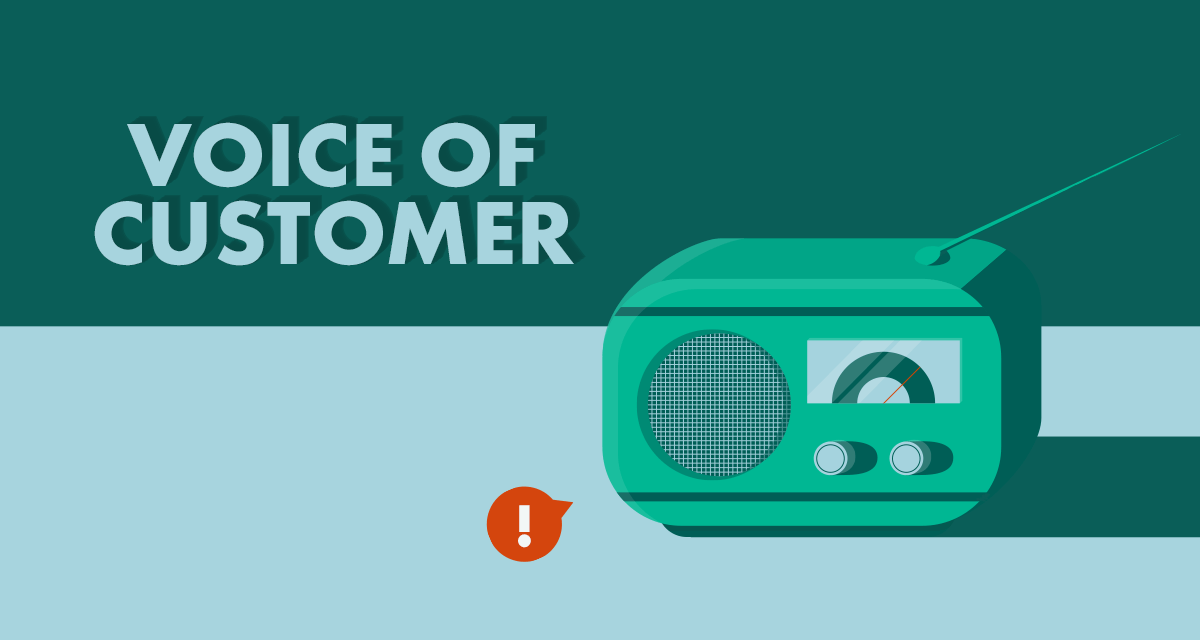Post Summary:
- What is Voice of Customer (VOC)?
- VOC data and customer experience (CX)
- How to collect and use VOC data (with examples)
What do you typically use customer feedback for?
Perhaps it helps you improve your product or service.
Or deliver a much better customer experience?
But, what if you could use it to also increase your revenue?
Gartner research recently discovered that collecting customer feedback can increase upselling and cross-selling success rates by 15% to 20%.
The same report found that customer feedback can also help decrease the cost of retaining those buyers – as companies that actively engage in a voice of customer programs, spend 25% less on customer retention than those that don’t.
Another study, by The Aberdeen Group, called "The Business Value of Building a Best-in-Class VoC Program" discovered that companies that invest in customer feedback programs experience a much higher client retention, employee engagement and spend less on customer service.
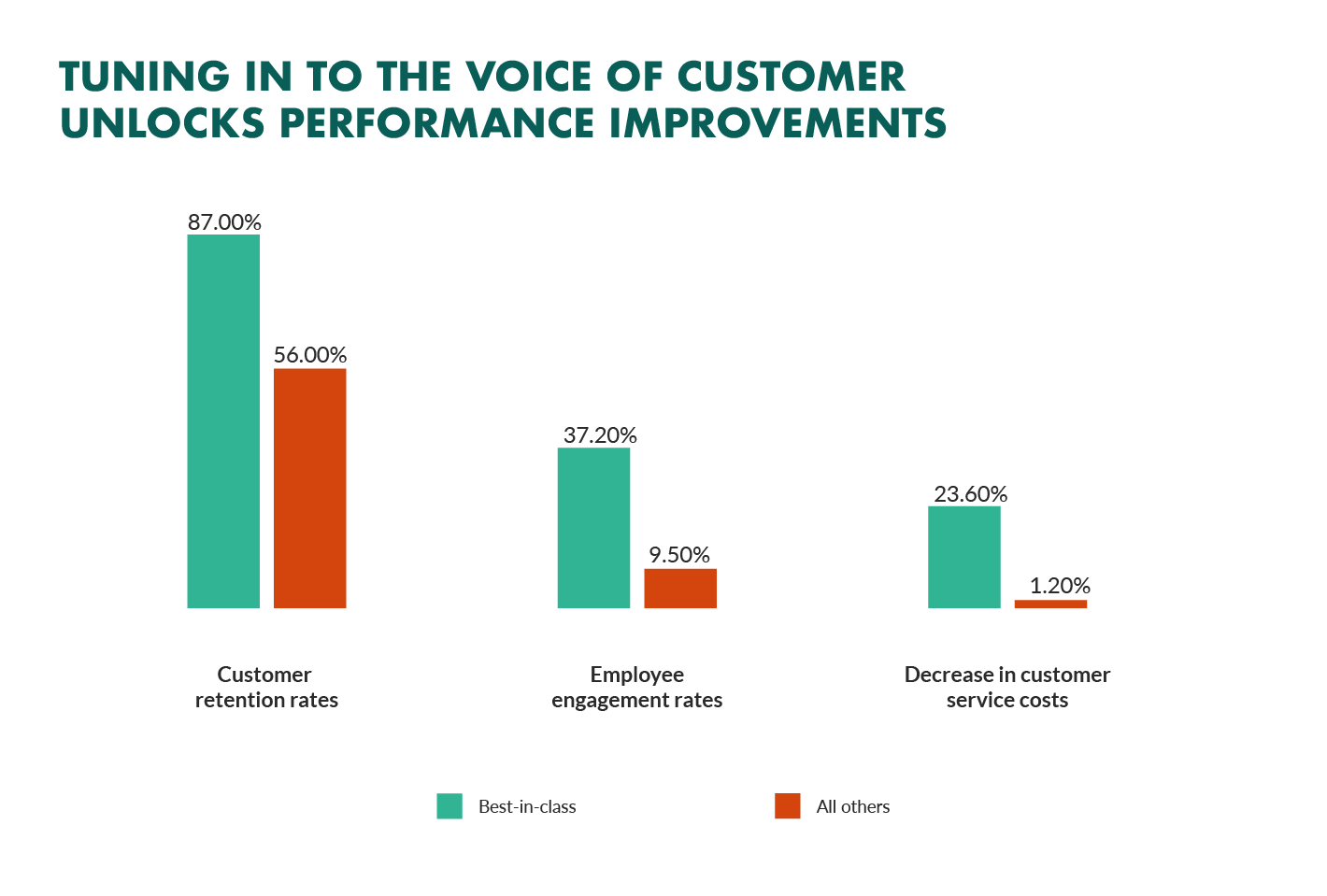
And best of all, the research also discovered that companies who implement a voice of customer (VOC) strategy generate a 10x greater year-over-year increase in annual company revenue.
Incredible, isn’t it?
However, to achieve similar results, you first need to understand what Voice of Customer is and then, how you can collect and use the feedback to grow your business.
What is Voice of Customer (VOC) Data?
Voice of customer data is a research strategy aimed to help you discover what your customers think of your business, product or service.
The term itself was first used by Abbie Griffin and John R. Hauser in a 1993 MIT Marketing Science paper, titled “The Voice of Customer” who described VOC this way:
[VOC] provides a detailed understanding of the customer’s requirements, a common language for the team going forward in the product development process, key input for the setting of appropriate design specifications for the new product or service, and a highly useful springboard for product innovation.
Two things stand out in this definition:
- “Detailed understanding of the customer’s requirements” - revealing that VOC provides an unparalleled insight into what your customers really want from your business, product, etc. (Unparalleled as it comes directly from the people you want to buy from you.)
- “Common language for going forward in product development, etc.” - As a result of that insight, the voice of customer data becomes a platform for making highly-informed business development decisions.
Before we get into the methods of collecting feedback, let’s review the process that you need to employ in a voice of a customer program, which encompass three stages:
- Collection - Using methods like surveys, etc. to gather information from your customers
- Analysis - Examining responses to uncover commonalities and customer expectations
- Implementation - Acting on the insight to improve relevant areas of the business.

And it works.
After all, why would some of the biggest companies in the world like Amazon, Apple and Zappos be investing so heavily into VOC programs if they didn't?
Just consider this:
Apple CEO, Tim Cook, responds to up to 100 customer service emails every single day.
And Jeff Bezos, a VOC data advocate, has been known to forward emails from unhappy customers to members of his team demanding issues to be fixed immediately.
It’s no surprise that both Apple and Amazon top the Forbes’ list of the most admired companies.
And there’s the same amount of praise being heaped on Zappos customer service as well.
But, VOC isn’t just about improving customer service.
You can use it to improve customer loyalty, satisfaction rates and tangible outcomes as well through increased sales, referrals, and retention.
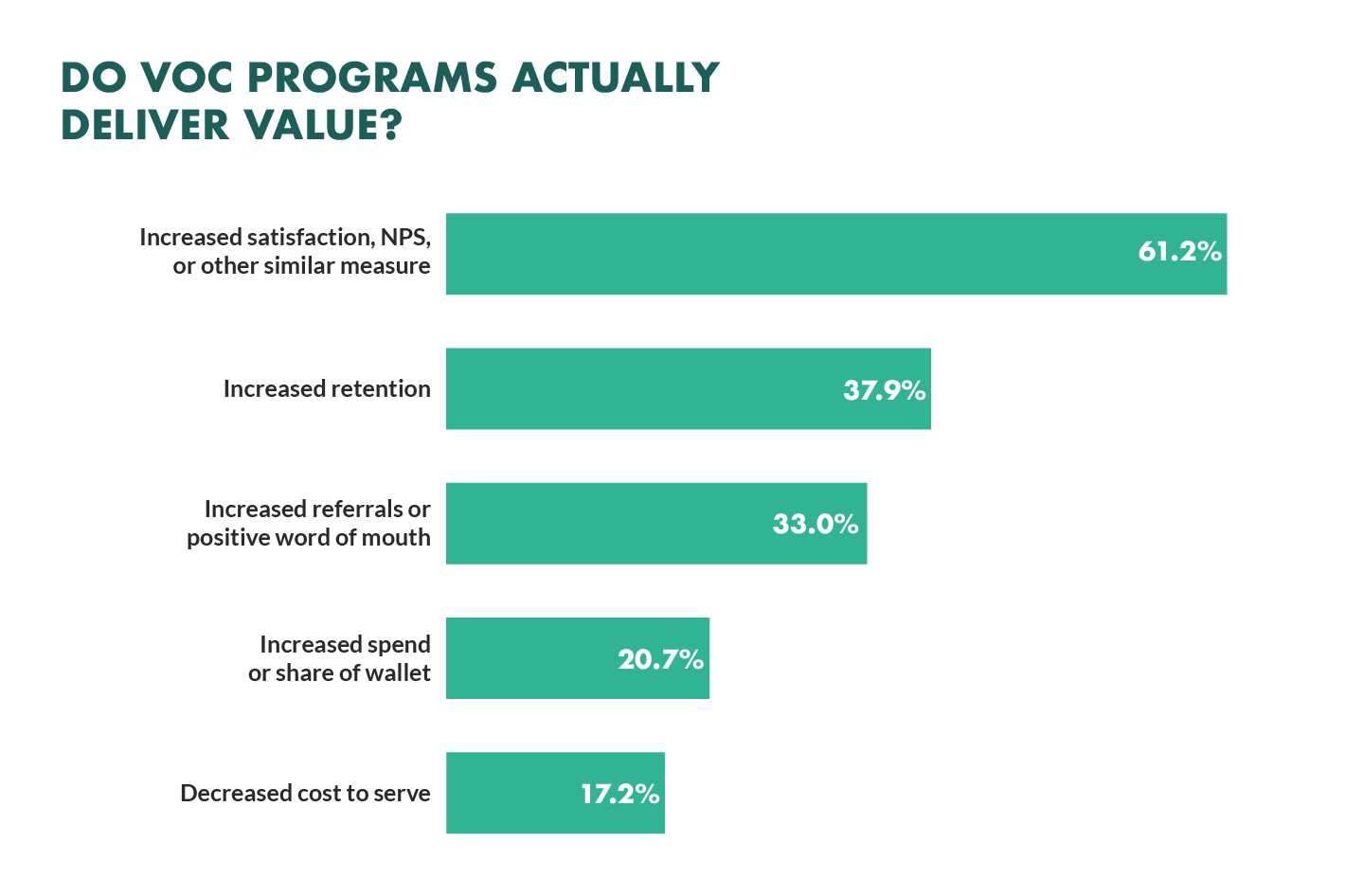
In other words, it proves the correlation between using customer feedback and achieving higher business growth.
How?
By tying VOC data to customer experience (CX).
The Link Between VOC Data and Customer Experience (CX)
The secret to retaining customers isn’t a price or product.
It’s the customer experience (CX) that your company offers.
That’s why 86% of customers are willing to pay more for a better customer experience!
In fact, companies are beginning to consider CX as a far greater opportunity than content, mobile or personalization.
The reason for this is simple:
Customer experience encompasses the entire buyer’s journey and beyond.
It starts from when a prospect hears about your company and continues with every interaction with your company until they eventually stop being a customer - the full end-to-end customer journey.
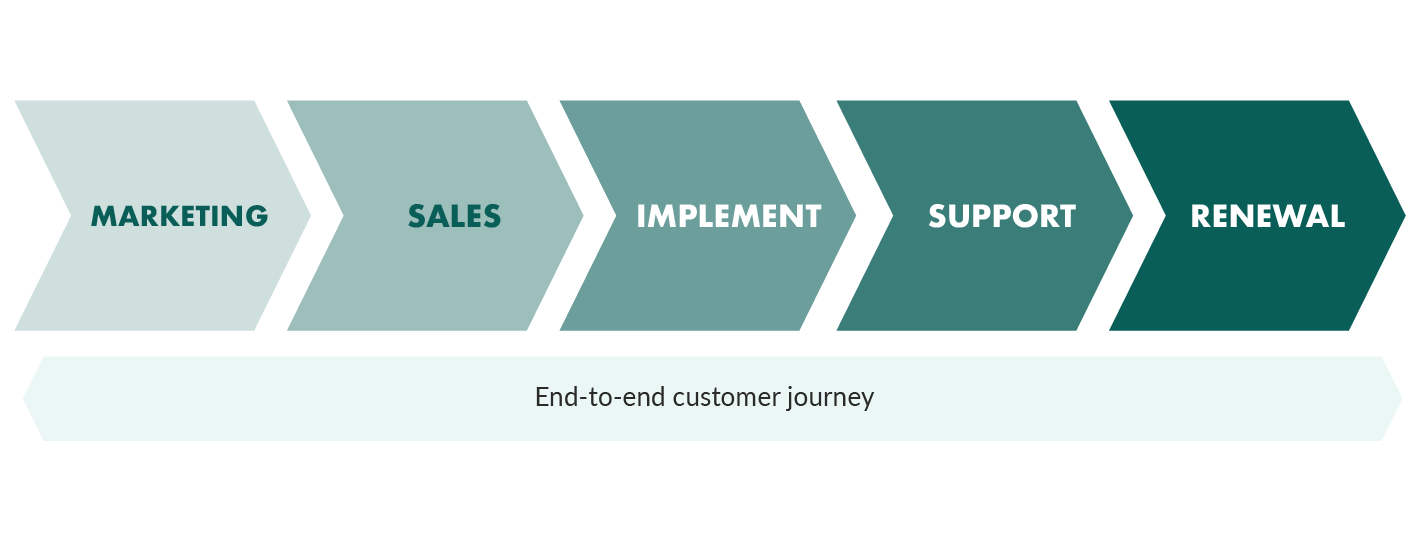
Moreover, customer experience is based entirely on your buyer’s expectations.
It’s what they wanted, and how you’ve delivered on it that forms a customer’s perception of a good or bad experience.
Now enter Voice of Customer data.
Collecting customer feedback helps you understand your customer expectations, and identify ways your company could deliver on those.
So, with that in mind, let’s take a look at different ways to collect customer feedback.
How to Collect VOC Data
Collecting feedback (providing you and your marketing team comply with GDPR) is as simple as asking your customers questions to uncover their expectations. And there are many different methods you can use to do this. To help you get started, here are five of the most common ways to collect customer feedback.
1. Surveys
Surveys offer the most scalable way to gather structured customer feedback.
Depending on your goals you can target any stage in the buying cycle from the first contact to a purchase.
You can use surveys for:
- When people are browsing on your website, you can ask them quick questions in context with the page they’re on.
- You can follow up with new buyers or leads using email as a way of delivering a more in-depth survey. You may wish to incentivize people to answer with a price discount or entry into a prize draw.
- And finally, you can interact and ask customers questions in real time, via phone surveys, for instance.
Before you start writing questions in your survey, think about the end-goal and what you are trying to achieve with the survey results.
2. Social listening
Social media is a great resource for collecting VOC data online.
Your customer’s posts describing positive interactions or sharing complaints with your company provide a great insight into their expectations, and how you’re currently delivering on those.
Social listening is more than Facebook, LinkedIn and Twitter. You can also collect feedback from online forums, blog comments, and product review sites - anywhere your customers can express themselves online.
3. Customer interviews
Speaking with customers can be intimidating, difficult, and certainly, time-consuming.
But at the same time, interacting directly with someone may help you uncover their particular experience, and not only hear about it but also assess it through other communication, like body language.
Twelve months ago, we interviewed our ideal customers to find out more about their purchase process. Among many other things, we found that our ideal customer profile preferred to sign up to a live demo rather than a free trial.
The problem? The demo sign up form was hidden.
Since the research, we've made several improvements to the website (copy, web forms, etc) and made sure the demo form is easy to find (it's now visible at the top of each page).
The results? A 71% increase in demo sign ups.
4. Focus Groups
Unlike one-to-one interviews, focus groups involve gathering a small group of people with a moderator to discuss a specific issue, product feature or a topic.
As Steven Telio, product manager at Build on Purpose points out:
Focus groups are used to understand who your ideal prospect is, what features to prioritize when you develop your products, who the competition is and to understand narrative and positioning into how to communicate with potential customers.
5. Net Promoter Score (NPS)
Net Promoter Score focuses on uncovering customer loyalty by asking only one, simple question:
“On a scale of 0 to 10, how likely are you to recommend us to a friend or colleague?”
Each time a customer responds to this question, the answer is then segmented based on predefined criteria:
- Promoters (9-10): These people are in love with your product or service and are likely to refer you to potential buyers. The customers who rate you a 9 or 10 are repeat customers and will have a high customer lifetime value.
- Passives (7-8): These people who rate you a 7 or 8 are content with being a customer of your business, but are the most likely to switch to a competitor should they find a new or better product.
- Detractors (0-6): These people are not happy with your product or service and are likely to damage your brand reputation by sharing their negative experience with their friends, family and connections.

What’s important about the NPS survey is that it focuses the customer on their entire experience with your product or service, not just the most recent encounter, giving great insight into the customer service you deliver.
How to use Voice of Customer (VOC) data
To begin with, you need to analyze VOC data and then, categorize the feedback to create an accurate picture of common customer problems, pain points, and improvement suggestions.
In practical terms, this means looking for patterns in the feedback.
For example, these could be common phrases your customers have used to describe why they use your product or challenges they face with it.
Next, you need to prioritize which of those you’re going to act on first.
Of course, those priorities will be different for each company. But, overall, there are three key areas you can apply your findings to; product development, marketing copy and customer experience.
1. Product development
By asking the right questions during your VOC data collection process and analyzing the results, you're going to uncover a wide range of opportunities, such as:
- Improvements that could boost your product’s usability
- Features that could help differentiate your product from the competition
- And suggestions for complementary products or services
By not listening to your customers, you could be missing out on a golden opportunity to improve your product line - or introduce new and complimentary products that could take your business in a new and more profitable direction.
In fact, using VOC data is what led to the development of a new feature. Based on direct customer feedback, we built and launched SuperOffice Chat, the only chat software on the market that is fully integrated with SuperOffice CRM.
The impact?
Our customers were quick to adopt chat and have used it to respond to more than 140,000 chat sessions with their own customers - helping them provide a better service to their customers.
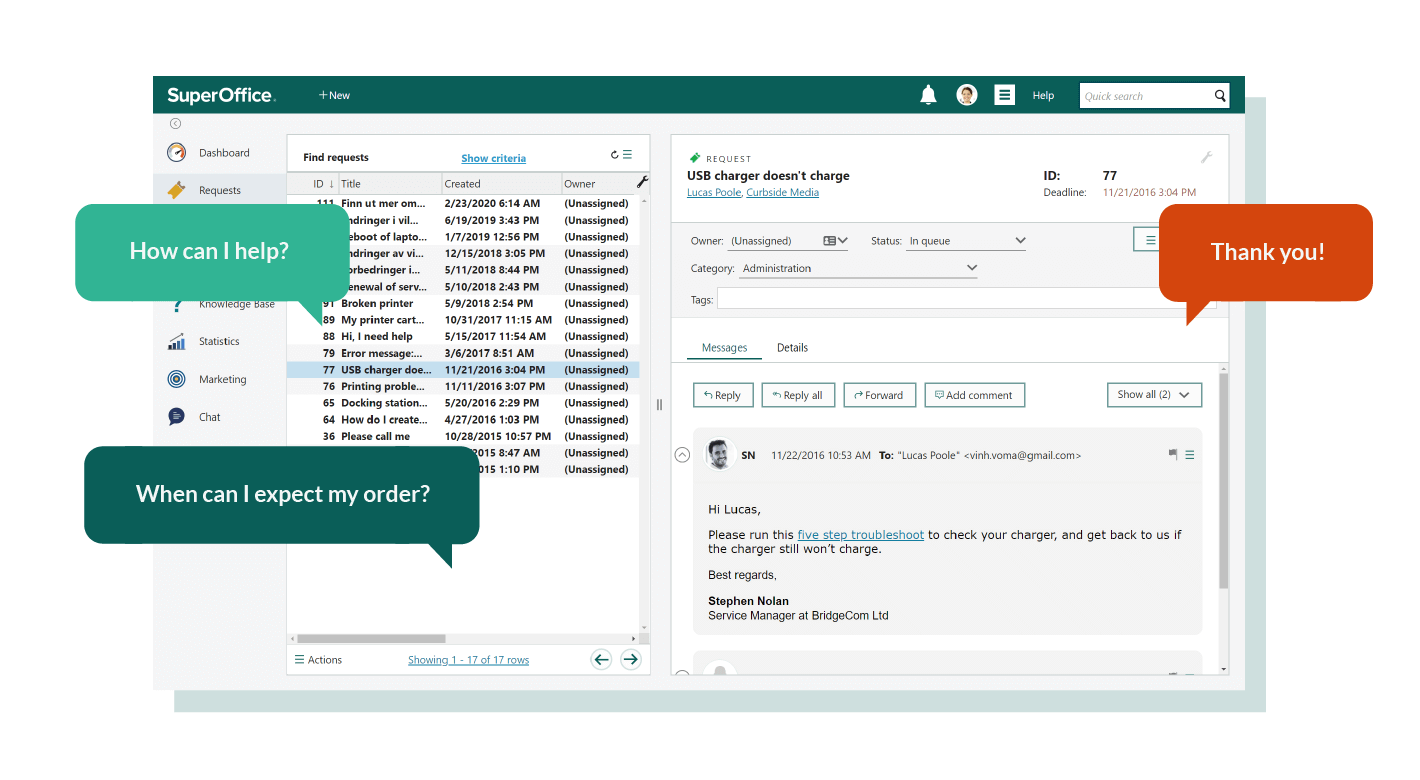
2. Marketing copy
Surprisingly, only 42% of B2B marketers collect feedback from customers as part of their audience research.
VOC data could help you uncover phrases and terms your customers use to describe what you sell. Needless to say, using your customers own words in your marketing copy could make your offer more relevant to the target market.
When analyzing your VOC data, try to look for phrases your customers have used to describe the reasons why they use your product, the benefits it offers them and the outcomes they have achieved with it.
If you take the time to do this, you’ll be able to use VOC data to write great website copy that helps you to:
- Showcase what makes your brand different
- Clearly explain who you are and what you and your product does
- Convert more visitors from browsers into buyers and boost product sales
We ask our potential customers what they want to achieve with CRM. Their feedback is the reason why we changed the key message on our home page to "Increase sales, improve customer loyalty" instead of "CRM software to build better customer relationships".
3. Customer experience
The more customers that have a positive experience with your brand, the faster you will grow.
But, if you're not delivering a good customer experience, then you can be sure that your customers will be sharing their thoughts about your brand online.
The Internet gives your customers a 24/7 outlet for venting their frustrations, which means they could be sharing their experience about a rude customer service employee or a poor experience they had with your website.
With VOC data, you can uncover areas that you need to focus on the most helping you boost customer satisfaction and also, reduce the number of complaints, both online and offline.
Having recently rolled out NPS, we will be using customer feedback to improve product, marketing and the entire customer experience at SuperOffice. Listening to customer challenges and identifying solutions is key to keeping customer for the long-term.
The impact?
NPS is a company-wide initiative and while it's still too early to see the impact, it's something we're working on and we will continue to improve every single time we receive feedback from a customer.
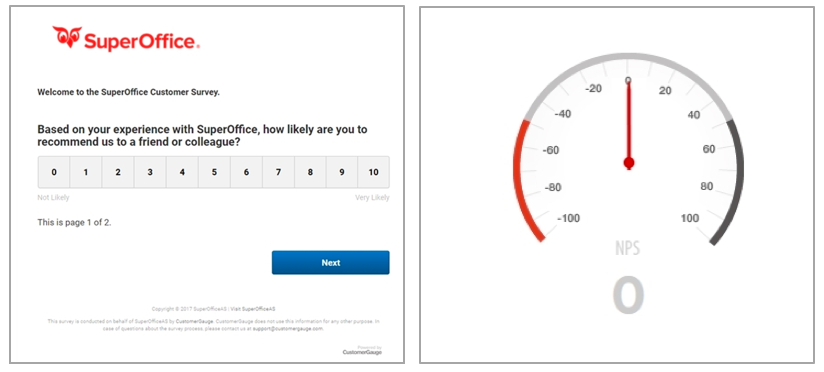
Conclusion
Voice of customer data is critical to the growth of your business.
Collecting customer feedback through surveys, interviews, focus groups and social listening can help you uncover areas where your company fails to deliver on customers’ expectations. You can then use this feedback to make your product better, create more compelling marketing copy and deliver an improved customer experience.
By tapping in to VOC data you will find opportunities that will improve the overall experience for both current and future customers – making it easier to increase retention rates and annual year-over-year revenue.
How have you used voice of customer programs in your company?
And has VOC data helped you increase revenue?
